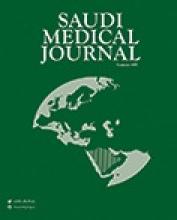Abstract
OBJECTIVE: To report on the clinical and biochemical features of patients who presented with stroke due to mitochondrial disorders amongst a prospective and retrospective cohort of Saudi children.
METHODS: Children, who presented with stroke, were evaluated at the Division of Pediatric Neurology, or admitted to King Khalid University Hospital, College of Medicine, King Saud University, Riyadh, Kingdom of Saudi Arabia, during the periods July 1992 to February 2001 (retrospective study) and February 2001 to March 2003 (prospective study). Open muscle biopsies were obtained from patients suspected to have mitochondrial disorders, and examined using conventional histological and histochemical techniques. Biochemical, molecular pathological investigations, or both, of muscle could be arranged for only some of the patients.
RESULTS: Mitochondrial disorders were the underlying risk factor for stroke in 4 (3.8%) of 104 children (aged one month to 12 years). Three patients (one male and 2 females) had Leigh syndrome (LS) and one had mitochondrial encephalomyopathy with lactic acidosis and stroke-like episodes (MELAS). At the time of stroke, the 3 children with LS were 11 months, 15 months, and 7 years old. They presented with psychomotor regression and seizures. Muscle histology and histochemistry showed mild non-specific changes but no ragged red fibers. Biochemical analysis of muscle (in one patient) revealed deficiency of pyruvate dehydrogenase complex. Analysis of mitochondrial DNA (mtDNA), [the other 2 patients] was negative for the 2 point mutations (T-G and T-C) at nucleotide position 8993, and for two T-C point mutations (at positions 8851 and 9176 of the ATPase 6 gene) that have been described in patients with LS. The girl with MELAS syndrome presented with a stroke-like episode at the age of 29 months and had focal brain lesions in the medial aspect of the left occipital and temporal lobes, and in the posteromedial aspect of the left thalamus, which resolved within 7 weeks. She had raised cerebrospinal fluid lactate but no ragged red fibers on muscle histochemistry. Biochemical assay of muscle homogenate showed reduction in respiratory chain complexes I, III and IV. Mutation screening of mtDNA at nucleotides 3243 (tRNALeu(UUR)) and 8344 (tRNALys) was negative.
CONCLUSION: Mitochondrial disorders constitute a risk factor for stroke in Saudi children. However, demanding and highly specialized investigations are needed to confirm the diagnosis. These are better performed at supraregional centers where facilities for clinical, biochemical and molecular work-up are available.
- Copyright: © Saudi Medical Journal
This is an open-access article distributed under the terms of the Creative Commons Attribution-Noncommercial License (CC BY-NC), which permits unrestricted use, distribution, and reproduction in any medium, provided the original work is properly cited.






